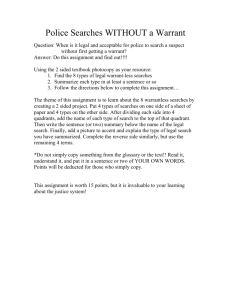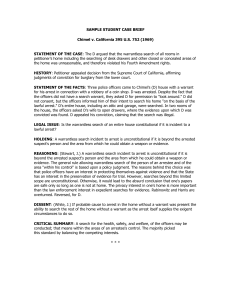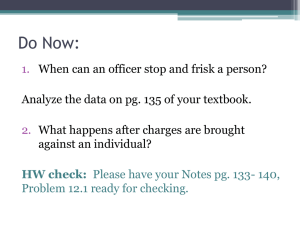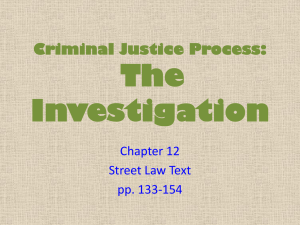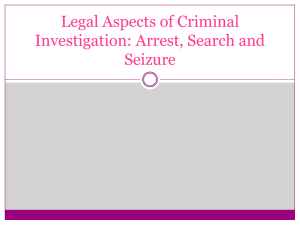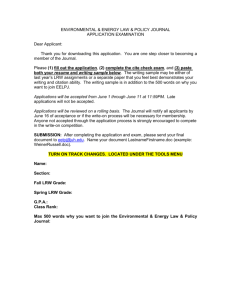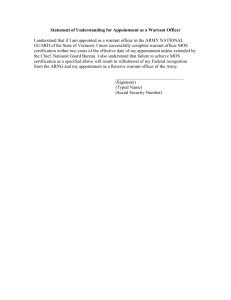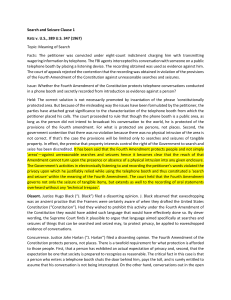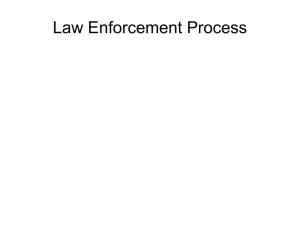Criminal Procedure, Class IV
advertisement
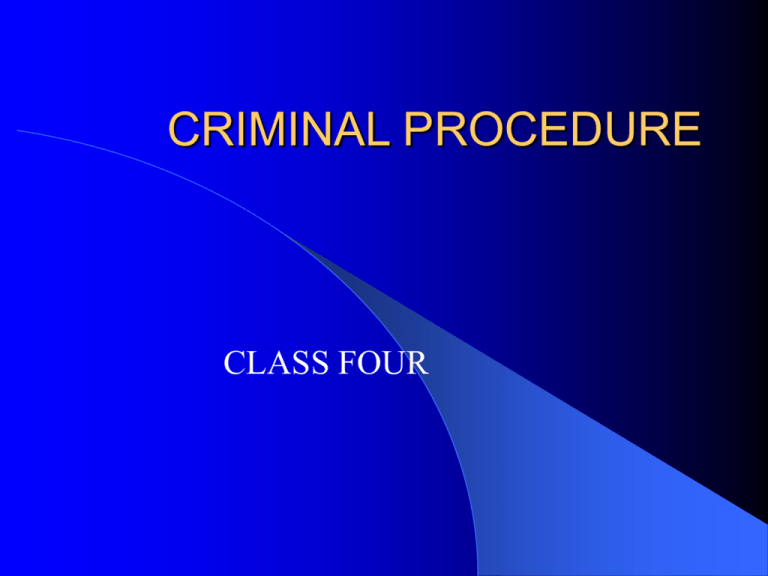
CRIMINAL PROCEDURE CLASS FOUR Today’s Topics Search Incident to Arrest Pretext Arrest Plain View and Plain Touch Automobile Searches Exigent Circumstances Special Needs Searches Administrative Searches SEARCH INCIDENT TO ARREST Search Incident to Arrest Major exception to warrant requirement Accepted practice when Bill of Rights adopted Scope of Search Suspect’s “grab” area Reasonable to search for both – Weapons – Evidence [contrast Terry] Post-Arrest Movement What impact on search incident to arrest when arrestee is allowed to move around to different areas? Contrast with Protective Sweep Conduct: quick and limited search of premises Purpose: looking for individual posing danger to officer or others Not automatic right Requires reasonable suspicion (Terry) Spatial limitations Search of Person Rule: With lawful custodial arrest, full search of person justified under 4th Amd Rationales: – Need to disarm person to take into custody – Need to preserve evidence Is search limited by type of crime for which person arrested? Search of Person Assume custodial arrest based on probable cause, what other justification is needed? What if officer has discretion to make full custody arrest to just issue a summons or citation? Impact on Automobiles Bright Line Rule: Contemporaneous to arrest of occupant, police may search passenger compartment Includes all containers found -- open or closed What is a container? Search Incident to Citation? Search incident to citation is NOT the same as search incident to arrest PRETEXT STOPS & ARRESTS Concerns Fear: Police might take advantage of relatively minor offense to forage for evidence of greater crimes Fear exacerbated if initial stop or arrest was motivated by impermissible reason, such as race Exercise Identify 3 key arguments on each side of debate Supreme Court’s Response Fact that officers had probable cause to believe D had violated traffic code renders stop reasonable under 4th Amd Only in very few areas has Court allowed officer motive to invalidate objectively justifiable behavior under 4th Amd If race-based selection, proper remedy is equal protection challenge Executive Branch Responses National State Local Plain View/Plain Touch General Rule Object of incriminating nature can be seized without warrant if in “plain view” of officer lawfully present at the scene Relationship to Warrant Clause Not an exception to warrant requirement Independent justification for seizure of goods taken Caution Plain view applies to warrantless seizure It does not authorize warrantless search for an item Requirements Officer within scope of lawful authority Probable cause that object is evidence of crime [or contraband] Probable cause immediately apparent [further search not necessary] Expansion to Other Senses Plain hearing Plain smell Plain touch [plain feel] Car Searches Areas of Concern Should there be an “automobile” exception to the warrant requirement? If so, what is its basis --- car’s inherent mobility, or reduced expectation of privacy? What about property that can be moved in and out of cars? Historical Conflict Object placed in car [probable cause precedes] – Chadwick [officers wait until footlocker is taken from train and put in car] – Saunders [officers wait until suitcase placed in taxi] Object found during search of car – Ross [informant tells officers D dealing drugs from trunk; police stop car] Contemporary Test Acevedo Police may search an automobile and containers within it where they have probable cause to believe contraband or evidence is contained in car One rule governs all automobile searches Distinguish Search Incident to Arrest Search incident to arrest needs no other justification Search incident to arrest is limited to passenger compartment Distinguish Search Incident to Arrest “Automobile exception” is exception to general warrant requirement Probable cause required to justify search under automobile exception Application to Passengers Acevedo and precursor cases involved warrantless searches of containers clearly owner by car’s driver Issue: Does automobile exception apply to search of passenger possessions in the car? Balancing Interests Government – Effective law enforcement – Ready mobility – Passenger often engaged in common enterprise with driver Individual – Reduced expectation of privacy – Traveling thorough public thoroughfares – Seldom serve as repository for personal effects – Subject to stops (pervasive gov’t control) Holding Officers with probable cause to search a car may inspect passenger belongings found in the car that are capable to concealing the object of the search Exercise Is the Supreme Court correct in its conclusions about expectations of privacy in cars? Are cars frequently a repository for personal effects? EXGIENT CIRCUMSTANCES Concept Exception to warrant requirement Theory: Impractical for officer to get warrant Implication: Immediate action required Examples Hot Pursuit Safety Evidence Destruction Application Questions Is type of crime a significant factor? Can doctrine be applied to permit seizing premises while warrant being obtained? Can doctrine be applied to permit restricted access to premise while warrant being obtained? SPECIAL NEEDS SEARCHES Concepts Analyzed under “reasonableness clause” of 4th Amd Searches made for purposes distinct from traditional law enforcement Purposes Distinct from Traditional Law Enforcement Might include: – Enforcing school policy – Upholding public safety – Promoting administrative efficiency Contrast traditional law enforcement needs: – Detect crime – Prosecute offenders Balancing Test If challenged conduct is supported by special needs beyond criminal law enforcement, then Court uses balancing test Need for search vs. Degree of invasion on personal rights Potential Hallmarks Search or seizure conducted for reasons either unrelated or only indirectly related to investigation of prosecution of crime Those conducting often are not police officers [although they can be] Those subject to conduct often are not criminal suspects ADMINISTRATIVE SEARCHES Safety Inspection of Homes Safety Inspection of Business Warrantless entry into probationer’s home Types of Justification Administrative probable cause Area-wide warrant Statute/regulation offering warrant equivalent Heavily Regulated Business Examples: liquor, pawnshops, weapons dealers, mines 3 criteria to support warrantless inspection – Substantial gov’t interest that informs regulatory scheme – Warrantless inspection necessary to further – Inspection program must provide constitutionally adequate substitute for warrant [certainty and regularity of application]

